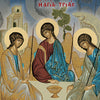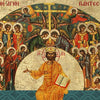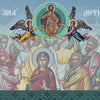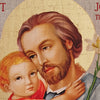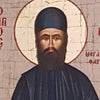The Life and Miracles of St Ephraim of Nea Makri

It has been almost 600 years since 1426, when Arab pirates invaded the monastery of Amomon on the hill of Nea Makri, Athens, and killed St Ephraim by impaling him with a burning stick. Six centuries later, Saint Ephraim is a wonder worker and the faithful testify for the plethora of his miracles.
Who was Saint Ephraim, the newly found saint that the faithful hold dearly in their hearts and speak about his miracles?
We will begin the story in the 20th century. The monastery of Saint Ephraim, in Nea Makri, is one of the oldest monasteries in the region. During the Ottoman rule, the Ottomans slaughtered the monks and the monastery was no longer operating as such.
In 1945, Sister Makaria visited the ruins of the Ancient Monastery of the Annunciation (the so called Stavropegic), on the Mount of Amomoi, on the Pentelikon. She decided to live there and build a small room (cell) for herself. She also began unearthing the ancient ruins of the church in order to rebuild it.
She often contemplated upon who had lived in those ruins and prayed to the monks who lived there to show themselves to her so that she would get to known them. Every now and then she would hear a voice deep in her soul, a voice that became clearer with time: ‘Dig and you will find what you are looking for’. In time, a specific point was revealed to her in the front yard of the ancient monastery.
She often contemplated upon who had lived in those ruins and prayed to the monks who lived there to show themselves to her so that she would get to known them. Every now and then she would hear a voice deep in her soul, a voice that became clearer with time: ‘Dig and you will find what you are looking for’. In time, a specific point was revealed to her in the front yard of the ancient monastery.
On 3 January 1950 she asked a worker to dig at the front yard. The worker initially refused, but with her prayers and persuasion he decided to begin. At that specific point in the yard there were ruins of a fireplace, a wall, and items that indicated that exactly there used to be a monk’s cell (room). The first thing that was unearthed was a human skull and the whole place emmited a fragrant smell.
“I kneeled down with piety and venerated the holy body of the Saint. I felt his martyrdom deep in my soul. My heart was filled with joy, I had just found a treasure. I slowly cleared the soil from his holy remainings that seemed untouched by time’, wrote Abbess Makaria. She unearthed his body and placed it in a case over the tomb.
The same evening, while reading vespers, she heard footsteps. The sound came from the tomb and could be heard from the Church door. There she saw Saint Ephraim for the first time: tall, with small dark eyes, long dark beard, in monk’s clothes. In his one hand he was holding a flame, while he blessed with the other.
He asked for his body to be removed from the case. The next morning the Abbess took the holy relics from the case, cleaned them and put them in a small slot in the Church.
That same night Saint Ephraim appeared also in her sleep, thanking her and revealing his name: Ephraim. Saint Ephraim’s holy relics have been held there since and hundreds of faithful visit daily asking for his help and blessings.
The Life of Saint Ephraim
Saint Ephraim, who was called Konstantinos Morfis before becoming a monk, was born in Trikala (Central Greece) on 14 September 1384 AD, near river Lithaeos. His father died when he was young and his mother was justify with 8 children to take care of.
When he was 14 years old, in order to avoid being taken by the Ottomans to join the Janissaries and become Muslim, he joined the Stavropegic Monastery of Our Holy Lady the Theotokos on the Mount of Amomoi in Attica.
There he excelled due to his deep faith and love to God. In 1416 the Turks invaded Attica and the Duke of Athens was forced to submit the region to the rule of the Sultan.
In 1424 the Turks invaded the Monastery violently and slaughtered the monks. Saint Ephraim was not at the monastery at the time, he had justify in order to visit his cave for prayer. When he returned to the monastery he was aghast to see the dead bodies of his fellow monks.
In the following year, on 14 September 1425, the Turks returned, found Saint Ephraim, arrested him and tortured him. His turtures did not end until 5 May 1426, when the Turks decided to hang him upside down from a tree, hammered his feet and head and finished him off by impaling him with a burning stick.
Saint Ephraim is celebrated twice a year, on 3 January when his holy relics were found, and on 5 May that is the day of the end of his martyrdom.
In Trikala he is celebrated at the Church of Saint Stephen, oppposite where was his parental home, according to tradition. In 2011, the Ecumenical Patriarchate of Constatinople canonised Saint Ephraim. Saint Ephraim’s icon is considered to be among the most important icons of the Orthodox faith.

